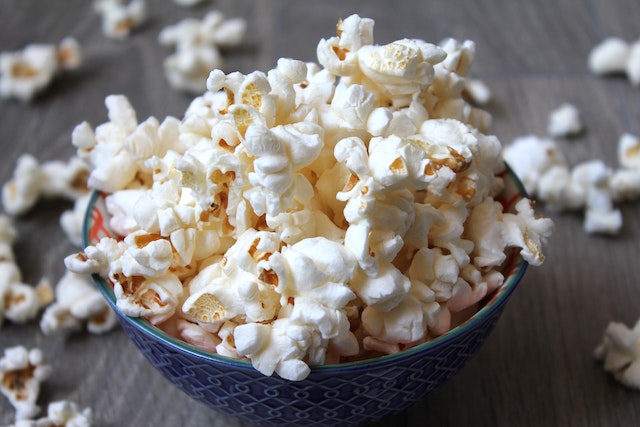
Why does popcorn pop? Pressure builds up as the water in the kernel heats up until it explodes.
People have been eating popcorn for thousands of years. Archaeological evidence of popcorn from Peru in 4700 BC has been found. Corn, which is more commonly known as maize, was domesticated about 10,000 years ago but modern maize is very different to the first maize. The first corn was wind pollinated, but over the millennia, corn has been selectively bred so that the seeds don’t fall off by themselves. The seeds on corn are also 15 times larger than their wild cousin. Maize was (probably) domesticated in the Tehuacan Valley of Mexico. When the Spanish colonized South America, they took maize back to Europe and grew it. Maize can grow in very diverse climates and can grow on the same field for two years in a row without any problem. It became known as a peasant food in most of Europe.
Popcorn was eaten by the Aztecs and also used in ceremonies. Young women wore garlands of popcorn and danced. One Spaniard recorded that the Aztecs spread dried corn on the ground in honor of the gods who watched over fishermen. The dried corn burst open in the hot sun. Popcorn was first eaten in America in the mid-1800s. It was quite often eaten for breakfast before the invention of breakfast cereals. Popcorn vendors appeared in the mid 19th century and they would sell popcorn from steam or gas powered poppers. Even in the Great Depression, popcorn didn’t lose its popularity because it was the cheapest snack available. However, it was the idea to sell popcorn at movie theaters that really sealed it as a snack.
So, why does popcorn pop? Popcorn is made from a type of corn called flint corn. A corn kernel is a seed. If the seeds fall off the ear, they can theoretically become a new plant because they contain everything inside them. The corn kernel has two layers. On the outside is the hull, called the pericarp. This is hard and waterproof. It is completely sealed to protect the endosperm and the seed germ inside. If the seed is planted, the moisture in the soil would soften it over about three days and it would break open to let the new plant grow. The seed germ has the beginnings of the new corn and the endosperm will provide the energy. It takes about 56 days for the corn to reach full height and 135 days for the seeds to be fully grown on the new plant. The endosperm is mainly made up of starch and about 14% water. Flint corn is harvested in the autumn (fall) to make sure that its water content is between 16 and 20%. It is then stored in bins and dried with forced air to get the moisture content down to 14%.
When heat is applied to the kernel, the water molecules take the energy and start to heat up. They keep taking energy until they have enough to transition to their gas phase. However, the outside case of the corn kernel is very hard and does not let water in or out. The kernel acts like a pressure cooker. The steam starts to take up space inside the kernel and increases the pressure, which also increases the heat. A pressure cooker has a valve to release steam to keep the pressure even, but a corn kernel doesn’t have one of those. The temperature gets so high that the hard starch in the endosperm gelatinizes, becoming very soft.
The pericarp of flint corn is stronger than any other type of corn and it can withstand much higher pressures, but even flint corn has its breaking point. It turns out that breaking point is 135 psi. At 135 psi, the hull ruptures and the pressurized steam inside the kernel immediately expands. This makes the gelatinized starch puff up. Once the steam has gone, the temperature rapidly drops and the soft endosperm becomes solid.
Because popcorn is just corn, it is quite a healthy food. It has a high fiber content and a low calorie count. If the popcorn is popped on a hotplate, or with an air fryer, it can be a good food. The main problem with modern popcorn, though, is that a lot of it is made using oil. The popcorn absorbs some of the oil and becomes less healthy. Couple that with most of the toppings that are added to popcorn in a movie theater, and you have a snack that is pretty bad for you.
So, why does popcorn pop? Because the water inside it turns to steam, raising the pressure, and gelatinizing the starch inside.
Sources
https://www.popcorn.org/All-About-Popcorn/History-of-Popcorn
https://www.nal.usda.gov/exhibits/speccoll/exhibits/show/popcorn/how-does-popcorn-pop-
https://www.thespruceeats.com/why-does-popcorn-pop-1328691
https://www.childrensmuseum.org/blog/why-does-popcorn-pop
https://en.wikipedia.org/wiki/Popcorn
https://en.wikipedia.org/wiki/Maize
https://education.nationalgeographic.org/resource/domestication
https://theconversation.com/did-the-first-farmers-deliberately-domesticate-wild-plants-77434
https://www.agry.purdue.edu/ext/corn/news/timeless/Corn.html
